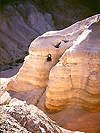|
Quintus Septimius Florens Tertullianus
Name of a Carthaginian lawyer and Christian
convert, who was born around 160 AD. Commonly known as Tertullian, this
early Christian author and theologian is regarded as one of the fathers
of Latin Christianity and played a significant role in the development
of early Christian thought in the Western Roman Empire. Quintus
Septimius Florens Tertullianus (ca. 155/160 – ca. 220/240 AD), wrote
primarily in Latin, producing apologetic, theological, and polemical
texts. He was among the first major Christian authors to write
extensively in Latin rather than Greek, which contributed to his lasting
influence on Western Christianity. He introduced and helped formalize
the concept of the Trinity in Western theology and emphasized strict
moral discipline and ascetic practices. Tertullian coined several Latin
theological terms, including Trinitas and persona, which were later used
in theological discourse regarding the persons of the Trinity, and
introduced the term New Testament, which derives from the Latin Novum
Testamentum. In his apologetic writings, such as Apologeticum, he
defended Christianity against Roman accusations and persecution,
articulating arguments in favor of Christian practices. Later in life,
he associated with the Montanist movement, a rigorous and prophetic form
of Christianity that often conflicted with the emerging orthodox church.
Tertullian’s legacy includes his influence on subsequent Western
theologians, including Augustine. His polemical style was noted for its
sharpness and confrontational approach, reflecting his commitment to
defending the Christian faith.


Qumran (קומראן)
Hebrew. A ancient settlement from the Hellenistic
period, located on a dry plateau about one and a half kilometer inland
from the northwestern shore of the Dead Sea in the West Bank, where
about 150-200 inhabitants lived. It is presumed constructed sometime
during the reign of John Hyrcanus (134-104 BC) or in decades later, and
was occupied for most of the years until it was destroyed by the Romans
in 68 AD or shortly after. It is best known as the settlement nearest to
the hiding place of the Dead Sea Scrolls in the caves of the sheer
desert cliffs and beneath, in the marlstone terrace. Many scholars
believe the location to have been home to the Essenes, a Jewish sect,
but also other interpretations have been proposed.

 |